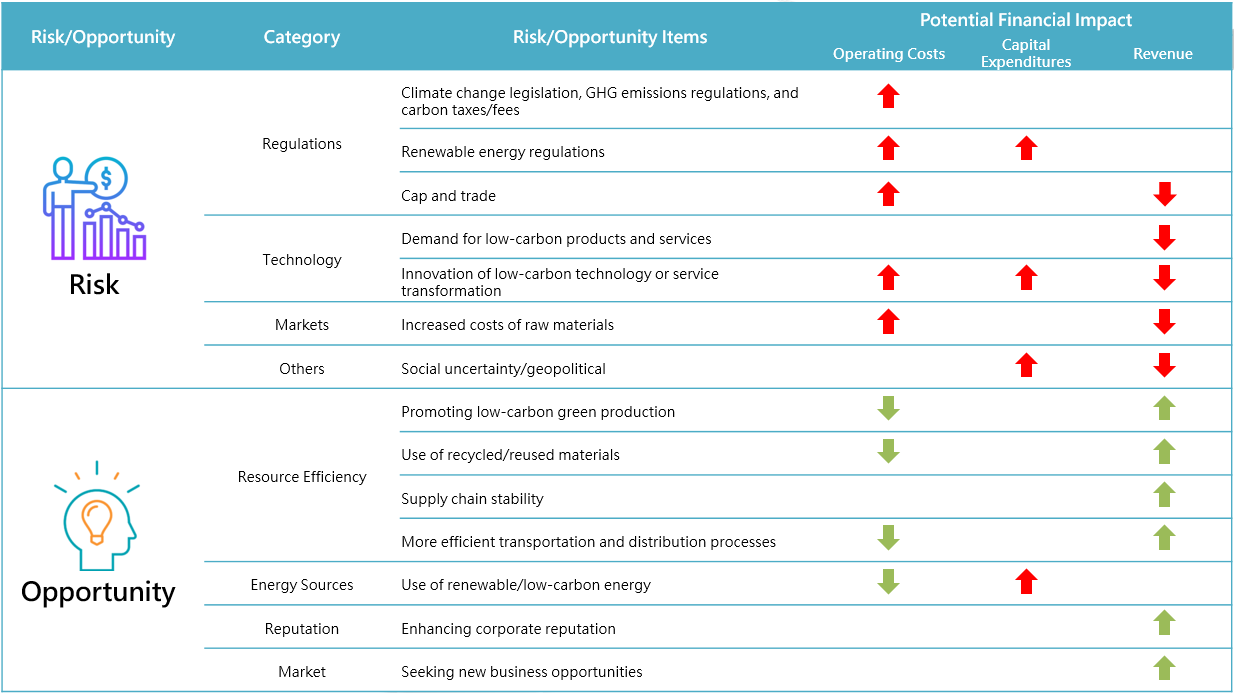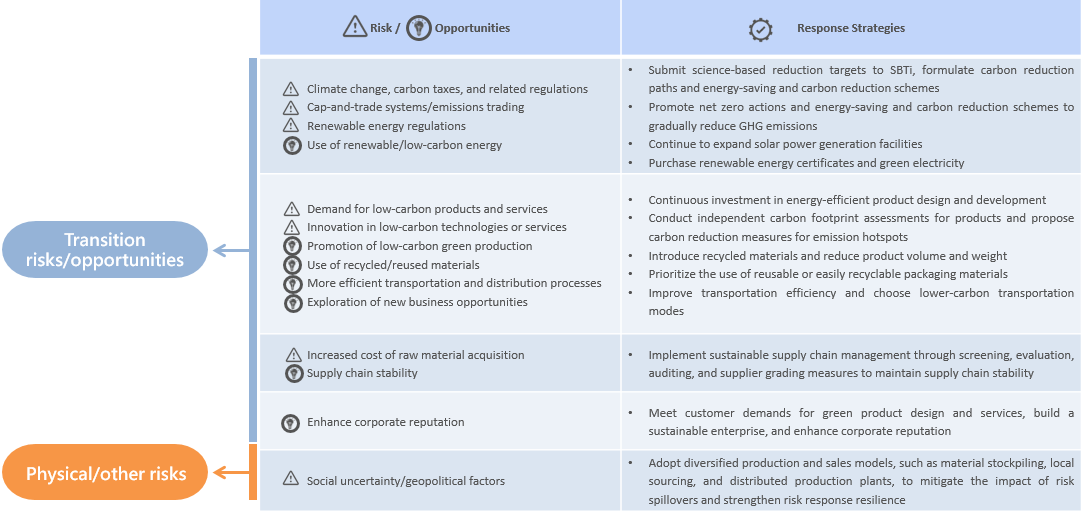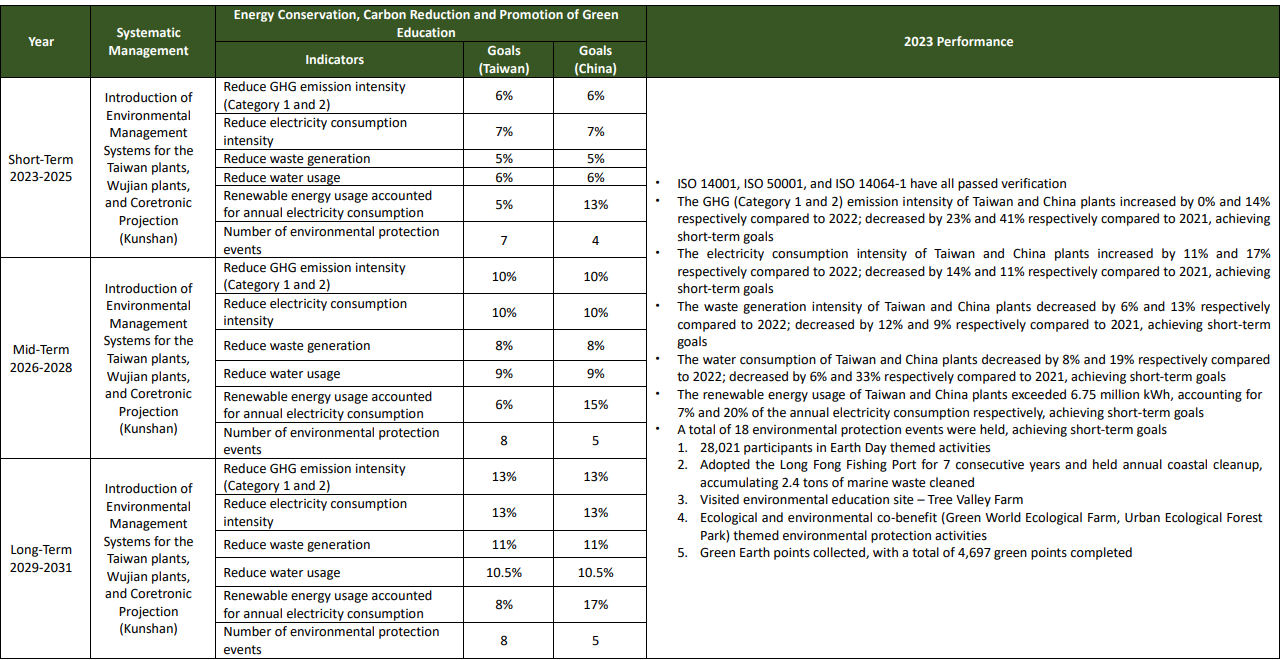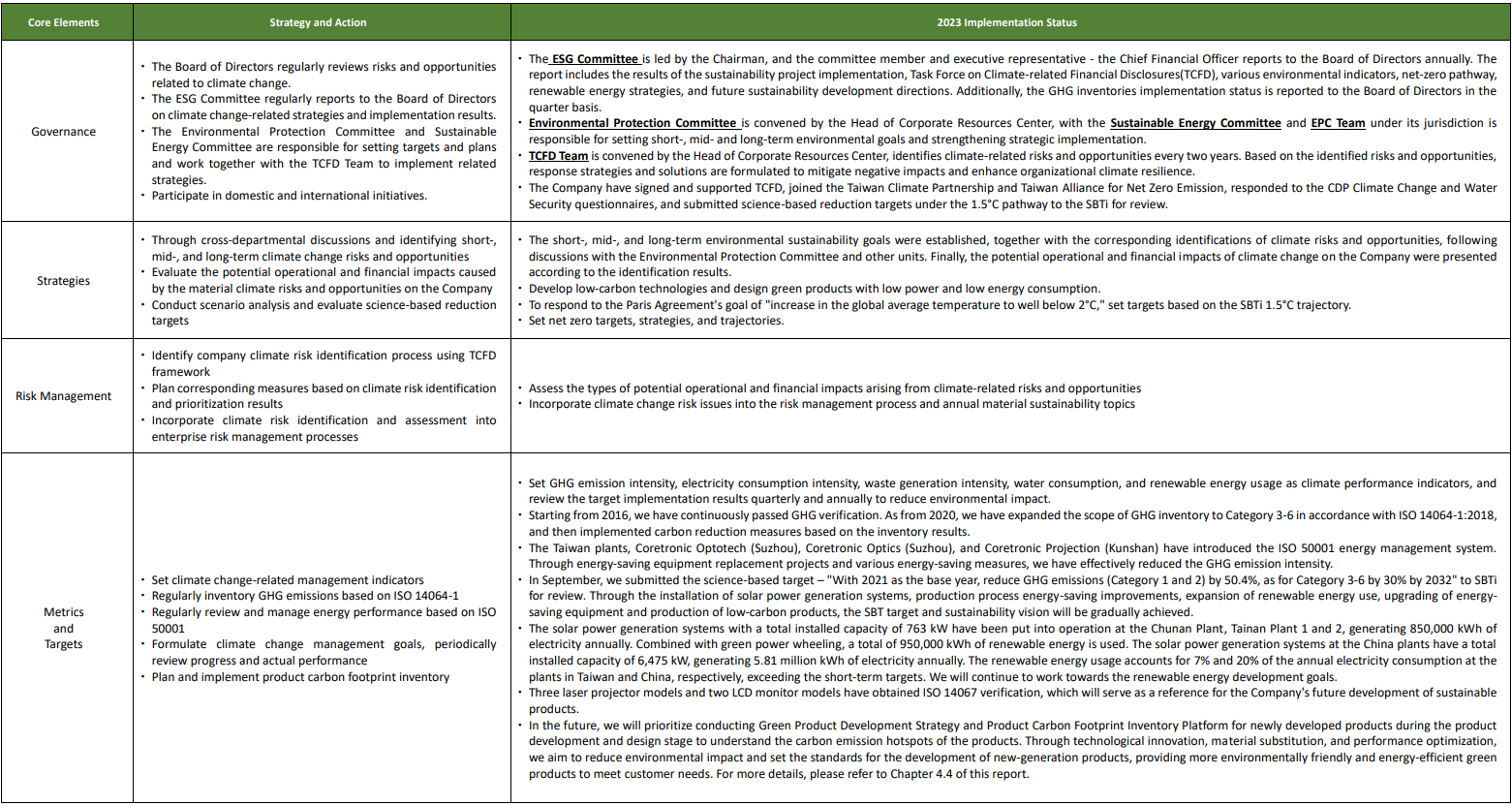Issue Date: July 31, 2024
Act on Climate Change
To effectively reduce the massive impact of extreme climate on the economy, society, and environment, Coretronic introduced the TCFD (Task Force on Climate-Related Financial Disclosures) framework in 2020 to reassess climate change risks. By focusing on low-carbon products and green operations, the Company has formulated energy-saving and carbon reduction strategies to mitigate the greenhouse effect. Additionally, in response to the Paris Agreement, the Company set the Carbon Reduction targets based on the SBT 1.5°C scenario for absolute emission reductions. The Group announced publicly its net-zero declaration in 2022, pledging to achieve "25% absolute reduction in GHG emissions (Category 1 and 2) by 2025, 50% absolute reduction in GHG emissions (Category 1 and 2) by 2032, and net-zero emissions by 2050."* Simultaneously, it submitted a commitment letter to the SBTi and plans to submit science-based carbon reduction targets for review by April 2024: "Based on the 2021 baseline, achieve an absolute reduction of 50.4% for Category 1 and 2 GHG gas emissions and 30% for Category 3-6 by 2032." The Company aims to achieve its net-zero vision through actively reducing fossil fuel use, increasing renewable energy usage, and implementing innovative low-carbon technology transitions. Additionally, considering the environmental costs of corporate carbon emissions and implement measures such as internal carbon pricing.
In 2023, the GHG inventory was conducted following the ISO 14064:2018 version to identify GHG emissions sources from Category 1 to 6. The organizational boundary includes the facilities under operational control of the Lixing Plant, Chunan Plant, Tainan plant 1 and plant 2 in Tainan Science Park, Coretronic Display (Suzhou), Coretronic Optotech (Suzhou), Coretronic Optics (Suzhou), Coretronic Projection (Kunshan), and Coretronic Optics (Kunshan). The total GHG emissions (Category 1 and 2) from Taiwan and China plants amounted to 25,325.9 tonCO2e, a 47% decrease compared to 2021, significantly exceeding the expected net-zero pathway.
*Science Based Targets (SBT) aim to limit global warming within 1.5°C by scientifically calculating the reasonable carbon reduction quotas for global industries and enterprises.
**This report's GHG emissions items consider the ISO14064-1:2018 standard and SBTi definitions, presented as "Category 1 = Scope 1, Category 2 = Scope 2, Category 3-6 = Scope 3".
TCFD Framework
Identifying Climate Change Risks and Opportunities
In the context of increasing attention to climate change regulations and net-zero targets, Coretronic actively participates and pays attention to international advocacy trends. In 2021, for the first time, it referenced the TCFD framework to identify climate change risks and opportunities and analyze potential financial impacts. The Company had re-identified and renewed those under-concerned items of risks and opportunities in 2023. In 2023, a total of 6 transition risks, 1 physical risk, and 7 opportunities were identified. For each risk and opportunity, a quantitative assessment of potential
impact type, potential impact intensity, and likelihood of occurrence was conducted. Risks and opportunities were then graded and ranked based on the assessment results, and strategies were formulated to address risks and opportunities, in order to mitigate negative impacts and enhance organizational climate resilience, while creating future business opportunities. In addition to identifying climate change risks and opportunities, potential financial impacts of each item were also analyzed to develop relevant plans and strategies.
Climate Change Risk and Opportunity Matrix

Potential Financial Impact Analysis of Climate Change Riskand Opportunity

Climate Risks and Opportunities Coping Strategies

Environmental Targets and Performance

Net-Zero Target and Achievement Status
- Announced the commitment of "25% reduction in GHG (Category 1 and 2) emissions by 2025, 50% reduction by 2032, and achieving net zero by 2050", and joined domestic and international initiatives such as the Taiwan Climate Partnership, Taiwan Alliance for Net Zero Emissions, TCFD, CDP, and SBTi.
- In 2022, submitted a commitment letter to SBTi, setting targets based on the SBT 1.5°C pathway. In September 2023, officially submitted the science-based targets to SBTi – "Using 2021 as the base year, achieve an absolute reduction of 50.4% in GHG (Category 1 and 2) emissions and 30% in Category 3-6 emissions by 2032". It was expected to obtain the verification in April, 2024.
- Being invited to complete the CDP for 5 consecutive years, in 2023, it received a B (Management Level) rating for climate change, higher than the industry, Asian and globalaverage levels (C). Among them, "Category 1 and 2 Emissions and Verification" and "Business Strategy, Financial Planning and Scenario Analysis" each received an A and A- (Leadership Level) respectively. The water security rating received a B (Management Level), higher than the industry, Asian and global average levels (C), with "Business Impact" and "Water Risk Assessment" both receiving an A (Leadership Level). The supplier engagement rating received the highest rating of A (Leadership Level), better than the industry, Asian and global average levels (C), with "Supplier Engagement", "Scope 3 emissions" and "Target Achievement" each receiving A, A and A- (Leadership Level) respectively.
- In 2023, the total GHG emissions (Category 1 and 2) from Taiwan and China plants amounted to 25,325.9 tonCO2e, a 47% decrease compared to 2021, with the absolute reduction significantly exceeding the expected net-zero pathway.
Environmental Protection Committee
Upholding the aim to implement energy conservation mechanisms, reduce greenhouse gas (GHG) emissions, fulfill corporate social responsibility, improve the overall corporate image, reduce operating cost, and assure sustainable business and development, we established the Environmental Protection Committee (EPC) in 2015 which holds a committee meeting every quarter (subject to the schedule of organizational budget planning) and provisional meetings where necessary to discuss and review the promotion and implementation of energy conservation, carbon reduction, and environmental protection. EPC promotes the following tasks on a long-term basis:
- Integration and promotion energy management and carbon emissions measures and environmental protection work.
- Enhancement of environmental awareness in employees and promotion of environmental education.
- Other topics and affairs relating to environmental protection.
The Members and Structure of the Committee
Chairman
Heads of Business Resource Center
To amass committee members, host committee meetings, and supervise normal committee operation.
Management Representative
the Management Representative of ISO 14001
To implement committee resolutions and review and gather the effectiveness of implementation.
Executive Secretary
Environmental Safety Division
To convene committee meetings, draw up energy conservation and carbon reduction programs, follow up the effectiveness of committee resolutions, manage committee meeting minutes and committee documents, and other tasks relating to committee operation.
Members of Committee
the Head or Representative of R&D, Manufacture, Product, QC, HR, IT, ER, Procurement, and Factory Affairs
Plan, promote, and executive all the issues and activities related to environmental protection in the organization.


